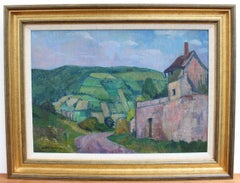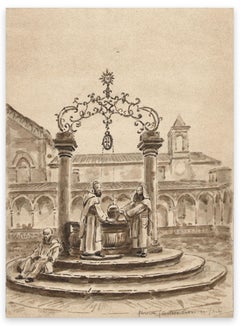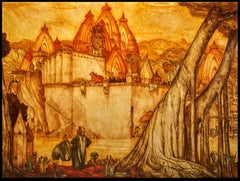André Maire Art
French, 1898-1984
André Maire was a French painter. Formally a student of André Devambez at the Beaux-Arts of Paris, his true debt was to Émile Bernard, though he belonged to no school. He lived for 13 years in Indochina.
to
1
3
1
1
2
1
2
1
Overall Height
to
Overall Width
to
2
1
2
2
2
2
3
1
3
6,938
3,292
2,514
1,213
3
2
2
1
1
Artist: André Maire
Landscape with House in the Cote d'Or
By André Maire
Located in London, GB
'Landscape with House in the Cote d'Or', oil on board, by André Maire (1960). Semur-en-Auxois was the town in which Maire lived in the 1960s in the Cote d'...
Category
1960s Expressionist André Maire Art
Materials
Oil, Board
Monks at the Well - Ink and Watercolor Drawing by André Maire - Mid-20th century
By André Maire
Located in Roma, IT
Monks at the well is an original watercolored drawing in ink on paper, realized by the French artist André Maire (1898-1985). Unsigned.
With autograph pe...
Category
Mid-20th Century Modern André Maire Art
Materials
Watercolor, Ink
Florence - Certosa - Original Ink and Watercolor Drawing by A. Maire - Mid 1900
By André Maire
Located in Roma, IT
Florence - Certosa is an original watercolored drawing on paper, realized by the French artist André Maire (1898 - 1985). Unsigned.
With autograph pencil...
Category
Mid-20th Century Modern André Maire Art
Materials
Watercolor, Ink
Related Items
Golf Bags, Caddy with Golf Bag on His Back
By Frederick Conway
Located in Missouri, MO
Framed Size: approx 17 3/4 x 20 3/4 inches
Fred Conway (1900-1973)
"Golf Bags, Caddy with Golf Bag on His Back"
Pen/Ink/Watercolor on Paper
Site Size: approx. 10 x 13 inches
Framed Size: approx. 17 3/4 x 20 3/4 inches
A member of the faculty of the Washington University Art School from 1929 to 1970, Frederick Conway...
Category
1960s American Modern André Maire Art
Materials
Paper, Ink, Watercolor, Pen
Three Horses Running
Located in Buffalo, NY
A modern Chinese watercolor painting depicting three stallions running underneath a blazing sun.
Category
1970s Modern André Maire Art
Materials
Paper, Archival Ink, Watercolor
Figurative Portrait in the Style of Ramiro Arrue, The Gypsy Caravan
By Ramiro Arrue
Located in Cotignac, FR
Figurative Expressionist portrait and scene of a travellers gypsy caravan. The painting is signed bottom right, Fayo (?) but further research is necessary for an attribution. Presented in a fine chip carved Montparnasse frame.
Provenance: from a Private French collection, South of France.
A strong and powerful scene, part portrait part scene of a travellers life. Both characters seem to be in quiet contemplation aware of each other but not looking. The artist has created a mood to the painting featuring simple lines with an almost monumental quality and muted colour harmonies. The work is very reminiscent of the paintings of Ramiro Arrue and the scenes of his beloved Basque country.
Ramiro Arrue was born in Bilbao, into an artistic family: his three older brothers, Alberto, Ricardo, and José, were also artists and frequently held joint exhibitions with him. He also had two sisters. Their father, Lucas Arrue, was an art collector who sold his collections (including a Goya) to pay for the artistic training of his sons. At the age of nineteen, Ramiro travelled to Paris to take courses at the Académie de la Grande Chaumière. Living in Montparnasse, he became an associate of his countrymen Ignacio Zuloaga and Paco Durrio, as well as the sculptor Antoine Bourdelle, who became a close friend. He was also associated with Picasso, Modigliani, and Jean Cocteau. In 1911, Arrue exhibited at the Salon des Artistes Français.
In 1922, along with his friends Philip Veyrin and Commandant William Boissel, he founded the Musée Basque at Bayonne.
In 1925 Arrue won a gold medal at the Exposition Internationale des Arts Decoratifs. He exhibited in Bayonne, Pau, Strasbourg, Bilbao, and Cordoba. Along with his brother José, he travelled and exhibited in South America, to Buenos Aires and Montevideo. He often, however, returned to the Basque Country, particularly to Saint-Jean-de-Luz, where he settled in 1917 and where he found his main inspiration for landscapes, portraits, and everyday scenes. In 1929, he married Suzanne: they went on honeymoon in St. Tropez.
Arrue produced illustrations for Francis Jammes (La Noce basque), Pierre Loti (Ramuntcho), Joseph Peyré (Jean le basque...
Category
Mid-20th Century Expressionist André Maire Art
Materials
Oil, Board
H 30.71 in W 26.38 in D 1.58 in
"Great Pine", Tree Inhabited by Human in Nature, Drawing and Pigments on Paper
By Frank Girard
Located in Clermont-Ferrand, Auvergne-Rhône-Alpes
This drawing by Frank Girard is created with pigments, Chinese ink, watercolors, acrylic, and colored pencils on 300g/m2 neutral white paper. It is not fr...
Category
2010s Realist André Maire Art
Materials
Paper, Color Pencil, Acrylic, Ink, Watercolor, Pigment
H 25.6 in W 19.69 in D 0.02 in
Circle of Chaïm Soutine, Expressionist painting of Fishermen in a French harbour
Located in Harkstead, GB
A very stylish image of a French harbour. Painted with great panache - wonderful brushwork and a vivid palette, reminiscent of the work of Chaim Soutine
Circle of Chaïm Soutine (189...
Category
20th Century Expressionist André Maire Art
Materials
Board, Oil
H 14.5 in W 18 in D 1 in
Mejdel Yaba
By James McBey
Located in Storrs, CT
Mejdel Yaba. 20 September, 1918 Pencil, ink and watercolour on paper. 8 1/8 x 22. Provenance: The Fine Art Society. Annotated, upper left, "due N at ???' Dated on the ink drawing on ...
Category
Early 20th Century Modern André Maire Art
Materials
Watercolor, Ink
Danish Mid Century Colourfield Landscape
Located in Cotignac, FR
Danish mid century Colourfield oil on board painting of a rural landscape by Poul Møller. The painting is initial signed and dated bottom right and there i...
Category
Mid-20th Century Expressionist André Maire Art
Materials
Board, Oil
Original-London St. Pancras-UK Artist-Rare watercolour & ink on collaged paper
Located in London, GB
This Ink and watercolour masterpiece is featured in Bloomsbury's 2011 publication, showcasing the artist's sketchbook (Note 1).
Created en plein air, Shizico Yi painted this piece in...
Category
2010s Contemporary André Maire Art
Materials
Watercolor, Handmade Paper, Ink
Free Shipping
H 16.93 in W 20.87 in D 0.87 in
Vintage Mid-Century Abstract Landscape Framed Oil Painting - Season
Located in Bristol, GB
SEASON
Size: 30 x 35 cm (including frame)
Oil on Board
A small yet characterful mid-century abstract painting, executed in oil onto board.
Although largely abstract in nature, the ...
Category
Mid-20th Century Expressionist André Maire Art
Materials
Oil, Board
Pastel, Ink Drawing Rocks And Cloud Landscape Jewish American Modernist WPA
By Ben-Zion Weinman
Located in Surfside, FL
Miniature Landscape
Provenance: Virginia Field, Arts administrator; New York, N.Y. Assistant director for Asia House gallery. (she was friends with John von Wicht and Andy Warhol)
Born in 1897, Ben-Zion Weinman celebrated his European Jewish heritage in his visual works as a sculptor, painter, and printmaker. Influenced by Spinoza, Knut Hamsun, and Wladyslaw Reymont, as well as Hebrew literature, Ben-Zion wrote poetry and essays that, like his visual work, attempt to reveal the deep “connection between man and the divine, and between man and earth.”
An emigrant from the Ukraine, he came to the US in 1920. He wrote fairy tales and poems in Hebrew under the name Benzion Weinman, but when he began painting he dropped his last name and hyphenated his first, saying an artist needed only one name.
Ben-Zion was a founding member of “The Ten: An Independent Group” The Ten” a 1930’s avant-garde group, Painted on anything handy. Ben-Zion often used cabinet doors (panels) in his work. Other members of group included Ilya Bolotowsky, Lee Gatch, Adolf Gottlieb, Louis Harris, Yankel Kufeld, Marcus Rothkowitz (later known as Mark Rothko), Louis Schanker, and Joseph Solman. The Art of “The Ten” was generally described as expressionist, as this style offered the best link between modernism and social art. Their exhibition at the Mercury Gallery in New York held at the same time as the Whitney Annual Exhibition of Contemporary American Painting, included a manifesto concentrating on aesthetic questions and criticisms of the conservative definition of modern art imposed by the Whitney. Ben-Zion’s work was quickly noticed. The New York Sun said he painted “furiously” and called him “the farthest along of the lot.” And the triptych, “The Glory of War,” was described by Art News as “resounding.”
By 1939, The Ten disbanded because most of the members found individual galleries to represent their work. Ben-Zion had his first one-man show at the Artist’s Gallery in Greenwich Village and J.B. Neumann, the highly esteemed European art dealer who introduced Paul Klee, (among others) to America, purchased several of Ben-Zion’s drawings. Curt Valentin, another well-known dealer, exhibited groups of his drawings and undertook the printing of four portfolios of etchings, each composed of Ben-Zion’s biblical themes.
Ben-Zion’s work is represented in many museums throughout the country including the Metropolitan, the Whitney, and the Museum of Modern Art in New York, the Art Institute of Chicago, the Philadelphia Museum of Art and the Phillips Collection, Washington. The Jewish Museum in New York opened in 1948 with a Ben-Zion exhibition.
“Ben-Zion has his hands on the pulse of the common man and his natural world”
As he emerged as an artist Ben-Zion never lost his gift for presenting the ordinary in ways that are vital, fresh and filled with emotions that are somber and exhilarating, joyous and thoughtful, and ultimately, filled with extraordinary poetic simplicity.
Ben-Zion consistently threaded certain subject matter—nature, still life, the human figure, the Hebrew Bible, and the Jewish people—into his work throughout his life. "In all his work a profound human feeling remains. Sea and sky, even sheaves of wheat acquire a monolithic beauty and simplicity which delineates the transient as a reflection of the eternal. This sensitive inter- mingling of the physical and metaphysical is one of the most enduring features of Ben-Zion's works." (Excerpt from Stephen Kayser, “Biblical Paintings,” The Jewish Museum Catalogue, 1952).
Along with ben Shahn, William Gropper, Chaim Gross and Abraham Rattner he was an influential mid century Jewish American...
Category
Mid-20th Century Expressionist André Maire Art
Materials
Pastel, Ink, Watercolor
Magazine Cover Illustration Mid 20th Century Modern Theatre Broadway Realism WPA
By Ernest Hamlin Baker
Located in New York, NY
Magazine Cover Illustration Mid 20th Century Modern Theatre Broadway Realism WPA
Ernest Hamlin Baker (1889 – 1975) “Today Magazine” Cover ...
Category
1930s American Modern André Maire Art
Materials
Gouache, Paper, Watercolor, Ink
Whimsical Fishing Illustration Cartoon 1938 Mt Tremblant Ski Lodge William Steig
By William Steig (b.1907)
Located in Surfside, FL
Lighthearted Illustration of Outdoor Pursuits This one of a fisherman signed "W. Steig"
Provenance: from Mrs. Joseph B. Ryan, Commissioned by Joe Ryan for the bar at his ski resort, Mount Tremblant Lodge, in 1938.
Mont Tremblant, P.Q., Canada
Watercolor and ink on illustration board, sights sizes 8 1/2 x 16 1/2 in., framed.
In 1938 Joe Ryan, described as a millionaire from Philadelphia, bushwhacked his way to the summit of Mont Tremblant and was inspired to create a world class ski resort at the site. In 1939 he opened the Mont Tremblant Lodge, which remains part of the Pedestrian Village today. This original illustration is on Whatman Illustration board. the board measures 14 X 22 inches. label from McClees Galleries, Philadelphia, on the frame backing paper.
William Steig, 1907 – 2003 was an American cartoonist, sculptor, and, in his later life, an illustrator and writer of children's books. Best known for the picture books Sylvester and the Magic Pebble, Abel's Island, and Doctor De Soto, he was also the creator of Shrek!, which inspired the film series of the same name. He was the U.S. nominee for both of the biennial, international Hans Christian Andersen Awards, as a children's book illustrator in 1982 and a writer in 1988.
Steig was born in Brooklyn, New York in 1907, and grew up in the Bronx. His parents were Polish-Jewish immigrants from Austria, both socialists. His father, Joseph Steig, was a house painter, and his mother, Laura Ebel Steig, was a seamstress who encouraged his artistic leanings. As a child, he dabbled in painting and was an avid reader of literature. Among other works, he was said to have been especially fascinated by Pinocchio.He graduated from Townsend Harris High School at 15 but never completed college, though he attended three, spending two years at City College of New York, three years at the National Academy of Design and a mere five days at the Yale School of Fine Arts before dropping out of each.
Hailed as the "King of Cartoons" Steig began drawing illustrations and cartoons for The New Yorker in 1930, producing more than 2,600 drawings and 117 covers for the magazine. Steig, later, when he was 61, began writing children's books. In 1968, he wrote his first children's book. He excelled here as well, and his third book, Sylvester and the Magic Pebble (1969), won the Caldecott Medal. He went on to write more than 30 children's books, including the Doctor DeSoto series, and he continued to write into his nineties. Among his other well-known works, the picture book Shrek! (1990) formed the basis for the DreamWorks Animation film Shrek (2001). After the release of Shrek 2 in 2004, Steig became the first sole-creator of an animated movie franchise that went on to generate over $1 billion from theatrical and ancillary markets after only one sequel. Along with Maurice Sendak, Saul Steinberg, Ludwig Bemelmans and Laurent de Brunhofff his is one of those rare cartoonist whose works form part of our collective cultural heritage.
In 1984, Steig's film adaptation of Doctor DeSoto directed by Michael Sporn was nominated for the Academy Award for Best Animated Short Film. As one of the most admired cartoonists of all time, Steig spent seven decades drawing for the New Yorker magazine. He touched generations of readers with his tongue–in–cheek pen–and–ink drawings, which often expressed states of mind like shame, embarrassment or anger. Later in life, Steig turned to children's books, working as both a writer and illustrator.
Steig's children's books were also wildly popular because of the crazy, complicated language he used—words like lunatic, palsied, sequestration, and cleave. Kids love the sound of those words even if they do not quite understand the meaning. Steig's descriptions were also clever. He once described a beached whale as "breaded with sand."
Throughout the course of his career, Steig compiled his cartoons and drawings into books. Some of them were published first in the New Yorker. Others were deemed too dark to be printed there. Most of these collections centered on the cold, dark psychoanalytical truth about relationships. They featured husbands and wives fighting and parents snapping at their kids. His first adult book, Man About Town, was published in 1932, followed by About People, published in 1939, which focused on social outsiders. Sick of Each Other, published in 2000, included a drawing depicting a wife holding her husband at gunpoint, saying, "Say you adore me."
According to the Los Angeles Times, fellow New Yorker artist...
Category
1930s American Modern André Maire Art
Materials
India Ink, Watercolor, Illustration Board
Previously Available Items
Indian Temple at Varanasi
By André Maire
Located in Paris, FR
Andre MAIRE (1898-1984)
Indian Temple at Varanasi
Dimensions:
– 150 x 200 cm (176 x 226 cm framed)
– 59 in. x 78 3/4 in. (69 1/4 in. x 88 in. framed)
Pro...
Category
1940s Modern André Maire Art
Materials
Oil
André Maire art for sale on 1stDibs.
Find a wide variety of authentic André Maire art available for sale on 1stDibs. You can also browse by medium to find art by André Maire in paint, ink, watercolor and more. Much of the original work by this artist or collective was created during the 20th century and is mostly associated with the modern style. Not every interior allows for large André Maire art, so small editions measuring 8 inches across are available. Customers who are interested in this artist might also find the work of Pierre Ambrogiani, Roland DUBUC, and Lucien Génin. André Maire art prices can differ depending upon medium, time period and other attributes. On 1stDibs, the price for these items starts at $423 and tops out at $4,270, while the average work can sell for $691.




